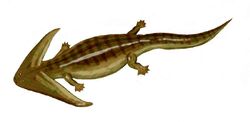| Amphibians or Amphibia Fossil range: Late Devonian-present | |
|---|---|
 Diplocaulus, a leponspondyl amphibian from the Permian period of North America. | |
| Scientific classification
| |
|
Superclass |
|
|
Class |
Amphibia |
|
Subclasses and Orders |
|
Amphibians are a class of cold-blooded animals that metamorphose from a juvenile, water-breathing form to an adult, air-breathing form. Typically, amphibians have four limbs. Unlike other land animals (amniotes), amphibians lay eggs in water, as their marine ancestors did. Amphibians are superficially similar to primitive amniotess.
Amphibians evolved in the Devonian Period and were top predators in the Carboniferous and Permian Periods, but many lineages were wiped out during the Permian-Triassic extinction event. One group, the metoposaurs, remained important predators during the Triassic, but as the world became drier during the Early Jurassic they died out, leaving a handful of relict temnospondyls such as Koolasuchus and the modern orders of Lissamphibia.
Evolutionary history[]
The first major groups of amphibians developed in the Devonian Period from fish similar to the modern coelacanth and lungfish where the fins had evolved into legs. These amphibians were around one to five meters long. The land was safe as the giant fish and sharks in the ocean could not come onto land. However, there were two problems with living out their entire lives on land. Primarily, the food that these amphibians consumed was in the water, but also at this point the skin on most of these amphibians was not water-tight.
In the Carboniferous Period, the amphibians moved up in the food chain and began to occupy the ecological position currently occupied by crocodiles. These amphibians were notable for eating the mega insects on land and many types of fishes in the water. During the Triassic Period, the amphibians started competing with proto-crocodiles, which led to their drop in size in the temperate zones, or leaving for the poles. Amphibians were able to hibernate during the winter, whereas crocodiles could not, allowing the amphibians in higher latitudes protection from the reptiles.
Taxonomy[]
Traditionally, amphibians have included all tetrapods that are not amniotes. They are divided into three subclasses, of which two are only known as extinct subclasses:
- Subclass Labyrinthodontia (diverse Paleozoic and early Mesozoic group)
- Subclass Lepospondyli (small Paleozoic group)
- Subclass Lissamphibia (frogs, toads, salamanders, newts, etc.)
Of these only the last subclass includes recent species.
With the phylogenetic revolution, this classification has been modified, or changed, and the Labyrinthodontia discarded as being a paraphyletic group without unique defining features apart from shared primitive characteristics. Classification varies according to the preferred phylogeny of the author, and whether they use a stem-based or node-based classification. Generally amphibians are defined as the group that includes the common ancestors of all living amphibians (frogs, salamanders, etc) and all their descendants. This may also include extinct groups like the temnospondyls (traditionally placed in the disbanded subclass "labyrinthodontia"), and the Lepospondyls. This means that there are a now large number of basal Devonian and Carboniferous tetrapod groups, described as "amphibians" in earlier books, that are no longer placed in the formal Amphibia.